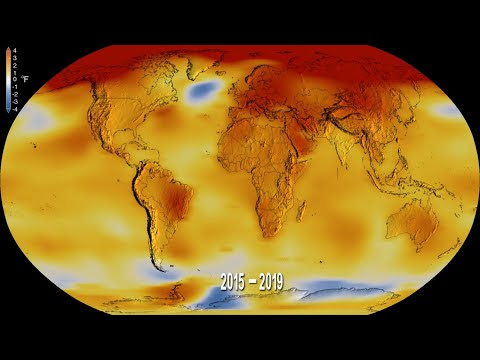Yes, the global warming is caused by human activities –
By Glynn Wilson –
The science is in. Yes, planet Earth is still growing hotter, and 2019 was the second hottest year since records have been kept beginning in 1880. And yes, the global warming is caused by humans burning fossil fuels for energy. There is no doubt about that.
According to independent analyses by NASA and the National Oceanic and Atmospheric Administration (NOAA), 2019 temperatures were second only to those of 2016. The science confirms that the planet’s long-term warming trend is continuing.
The past five years have been the warmest of the past 140 years, according to a new report that was just released on Wednesday and hit my email inbox just a few minutes ago.
The data shows that the global average surface temperatures for 2019 were 1.8 degrees Fahrenheit (0.98 degrees Celsius) warmer than the 1951 to 1980 mean, according to scientists at NASA’s Goddard Institute for Space Studies (GISS) in New York.
“The decade that just ended is clearly the warmest decade on record,” said GISS Director Gavin Schmidt. “Every decade since the 1960s clearly has been warmer than the one before.”
Earth’s long-term warming trend can be seen in this visualization of NASA’s global temperature record, which shows how the planet’s temperatures are changing over time, compared to a baseline average from 1951 to 1980. The record is shown as a running five-year average: NASA’s Scientific Visualization Studio/Kathryn Mersmann
Since the 1880s, the average global surface temperature has risen and the average temperature is now more than 2 degrees Fahrenheit (a bit more than 1 degree Celsius) above that of the late 19th century. For reference, the last Ice Age was about 10 degrees Fahrenheit colder than pre-industrial temperatures.
Using climate models and statistical analysis of global temperature data, scientists have concluded that this increase mostly has been driven by increased emissions into the atmosphere of carbon dioxide and other greenhouse gases produced by human activities.
“We crossed over into more than 2 degrees Fahrenheit warming territory in 2015 and we are unlikely to go back,” Schmidt said. “This shows that what’s happening is persistent, not a fluke due to some weather phenomenon: we know that the long-term trends are being driven by the increasing levels of greenhouse gases in the atmosphere.”
Because weather station locations and measurement practices change over time, the interpretation of specific year-to-year global mean temperature differences has some uncertainties, according to scientists. Taking this into account, NASA estimates that 2019’s global mean change is accurate to within 0.1 degrees Fahrenheit, with a 95 percent certainty level.
Weather dynamics may often affect regional temperatures, so not every region on Earth experienced similar amounts of warming, according to the report. NOAA found the 2019 annual mean temperature for the contiguous 48 United States was the 34th warmest on record, giving it a “warmer than average” classification.
The Arctic region has warmed slightly more than three times faster than the rest of the world since 1970, causing the loss of ice and rising sea levels.
Rising temperatures in the atmosphere and the ocean are contributing to the continued mass loss from Greenland and Antarctica and to increases in some extreme events, such as heat waves, wildfires and intense precipitation.
NASA’s temperature analyses incorporate surface temperature measurements from more than 20,000 weather stations, ship- and buoy-based observations of sea surface temperatures, and temperature measurements from Antarctic research stations.
These in situ measurements are analyzed using an algorithm that considers the varied spacing of temperature stations around the globe and urban heat island effects that could skew the conclusions. These calculations produce the global average temperature deviations from the baseline period of 1951 to 1980.
NOAA scientists used much of the same raw temperature data, but with a different interpolation into the Earth’s polar and other data-poor regions. NOAA’s analysis found 2019 global temperatures were 1.7 degrees Fahrenheit (0.95 degrees Celsius) above the 20th century average.















Excellent story. This news is all over the outlets in foreign countries but barely mentioned in the USA. We seem to be more concerned about who’s getting awards for the best films, etc.